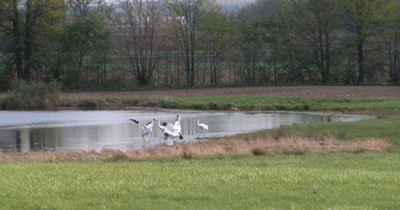By Nancy Allen
nallen@dailystandard.com Five rare and endangered whooping cranes that made Mercer County their home for the past three and a half weeks have left the area.

But the birds are still off their migration route, and whooping crane partnership officials soon may attempt to capture the birds and set them on the right course, said an Ohio Division of Wildlife official Monday.
Mark Shieldcastle, who works for the division, said the birds were last spotted near the Manistee River on the coast of Lake Michigan after leaving Mercer County on May 6. They had spent most of their time hopping between farm ponds in the Mud Pike area west of Celina, where they arrived on April 12.
The birds are part of an experimental flock being monitored by the Whooping Crane Eastern Partnership, under the auspices of the U.S. Fish and Wildlife Service. The group has been raising and releasing the birds into the wild since 2001. Each year since then, a batch of the young birds are fed by humans wearing hand puppets that look like adult whooping cranes and guided during their first migration in the fall by ultralight aircraft.
All the birds in the experimental flock have radio transmitters attached to their legs so they can be tracked by satellite and their locations known at all times. This is the second time this group of five birds has been stopped on their journey due to Lake Michigan. The birds are migrating from Florida to Wisconsin, and in April, a storm apparently blew the birds off course, causing them to head toward Lake Michigan. The lake poses a barrier to the whooping cranes because they do not fly over large, open bodies of water. The birds turned around and ended up in Mercer County.
After leaving Mercer County, the birds again ended up near Lake Michigan and stopped.
"Last week they (crane partnership officials) were discussing very hard doing something to capture them and now that they are in Michigan again, I am sure they are probably discussing it even harder," Shieldcastle said. "Because now they can't get back to Wisconsin on their own because they won't cross lake Michigan."
A group of three other birds that entered Ohio around the same time as the Celina birds also are in Michigan in the Alegan Wildlife Refuge close to Lake Michigan, Shieldcastle said. These three were spotted in Auglaize and Shelby counties in recent weeks.
Shieldcastle said just six of the total 16 birds from the 2003 flock have made it to Wisconsin's Neceda Wildlife Refuge.
Last year when a bird became lost and got into eastern Ohio, the bird had to be captured. Shieldcastle said a "puppeteer" from the Whooping Crane Eastern Partnership wearing a white sheet approached the bird and grabbed it.
There is only one remaining truly wild flock of whooping cranes, according to information found on the Whooping Crane Eastern Partnership Web site. This flock, numbering less than 200 birds, migrates annually from Wood Buffalo National Park in northern Canada to the Aransas National Wildlife Refuge on the Texas Gulf Coast. It was this flock that dwindled to 15 birds in the early 1940s. In the wild, whooping cranes usually raise just one chick a year and do not reach breeding age until they are 4 to 5 years old.
Active intervention on the part of the United States government, the Canadian government and numerous conservation groups helped pull the wild flock from the brink of extinction. The experimental flock started in 2001 numbers about 36, and a third non-migratory flock in Florida established in the 1990s by the U.S. Fish and Wildlife Service numbers about 90.
The birds are white with black wing tips and red on their foreheads. They stand 5 feet tall and have 7- to 8-foot wingspans. When courting, they do a dramatic dance where two birds face each other, spread their wings, bob their heads up and leap into the air. |

